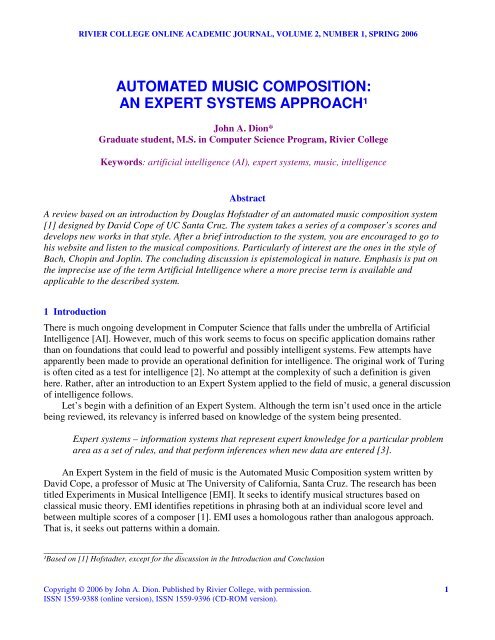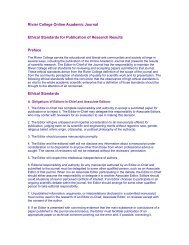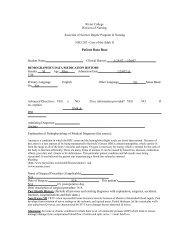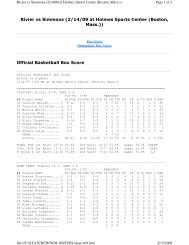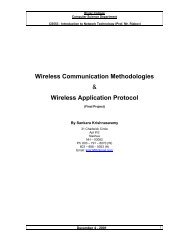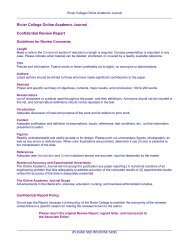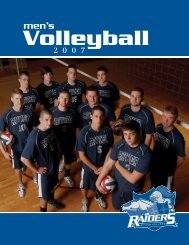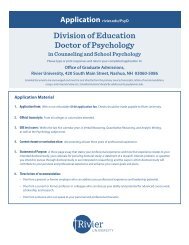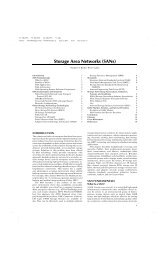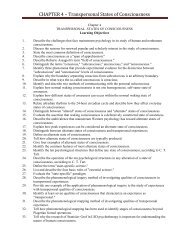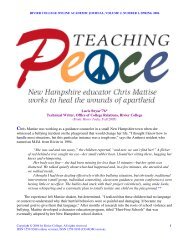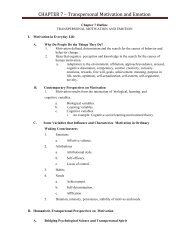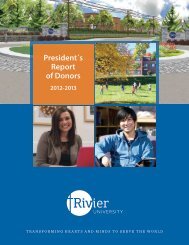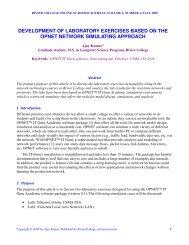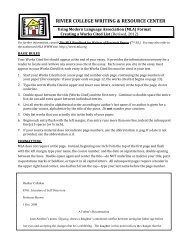automated music composition: an expert systems ... - Rivier University
automated music composition: an expert systems ... - Rivier University
automated music composition: an expert systems ... - Rivier University
Create successful ePaper yourself
Turn your PDF publications into a flip-book with our unique Google optimized e-Paper software.
RIVIER COLLEGE ONLINE ACADEMIC JOURNAL, VOLUME 2, NUMBER 1, SPRING 2006<br />
AUTOMATED MUSIC COMPOSITION:<br />
AN EXPERT SYSTEMS APPROACH¹<br />
John A. Dion*<br />
Graduate student, M.S. in Computer Science Program, <strong>Rivier</strong> College<br />
Keywords: artificial intelligence (AI), <strong>expert</strong> <strong>systems</strong>, <strong>music</strong>, intelligence<br />
Abstract<br />
A review based on <strong>an</strong> introduction by Douglas Hofstadter of <strong>an</strong> <strong>automated</strong> <strong>music</strong> <strong>composition</strong> system<br />
[1] designed by David Cope of UC S<strong>an</strong>ta Cruz. The system takes a series of a composer’s scores <strong>an</strong>d<br />
develops new works in that style. After a brief introduction to the system, you are encouraged to go to<br />
his website <strong>an</strong>d listen to the <strong>music</strong>al <strong>composition</strong>s. Particularly of interest are the ones in the style of<br />
Bach, Chopin <strong>an</strong>d Joplin. The concluding discussion is epistemological in nature. Emphasis is put on<br />
the imprecise use of the term Artificial Intelligence where a more precise term is available <strong>an</strong>d<br />
applicable to the described system.<br />
1 Introduction<br />
There is much ongoing development in Computer Science that falls under the umbrella of Artificial<br />
Intelligence [AI]. However, much of this work seems to focus on specific application domains rather<br />
th<strong>an</strong> on foundations that could lead to powerful <strong>an</strong>d possibly intelligent <strong>systems</strong>. Few attempts have<br />
apparently been made to provide <strong>an</strong> operational definition for intelligence. The original work of Turing<br />
is often cited as a test for intelligence [2]. No attempt at the complexity of such a definition is given<br />
here. Rather, after <strong>an</strong> introduction to <strong>an</strong> Expert System applied to the field of <strong>music</strong>, a general discussion<br />
of intelligence follows.<br />
Let’s begin with a definition of <strong>an</strong> Expert System. Although the term isn’t used once in the article<br />
being reviewed, its relev<strong>an</strong>cy is inferred based on knowledge of the system being presented.<br />
Expert <strong>systems</strong> – information <strong>systems</strong> that represent <strong>expert</strong> knowledge for a particular problem<br />
area as a set of rules, <strong>an</strong>d that perform inferences when new data are entered [3].<br />
An Expert System in the field of <strong>music</strong> is the Automated Music Composition system written by<br />
David Cope, a professor of Music at The <strong>University</strong> of California, S<strong>an</strong>ta Cruz. The research has been<br />
titled Experiments in Musical Intelligence [EMI]. It seeks to identify <strong>music</strong>al structures based on<br />
classical <strong>music</strong> theory. EMI identifies repetitions in phrasing both at <strong>an</strong> individual score level <strong>an</strong>d<br />
between multiple scores of a composer [1]. EMI uses a homologous rather th<strong>an</strong> <strong>an</strong>alogous approach.<br />
That is, it seeks out patterns within a domain.<br />
_______________________________<br />
¹Based on [1] Hofstadter, except for the discussion in the Introduction <strong>an</strong>d Conclusion<br />
Copyright © 2006 by John A. Dion. Published by <strong>Rivier</strong> College, with permission. 1<br />
ISSN 1559-9388 (online version), ISSN 1559-9396 (CD-ROM version).
John A. Dion<br />
2 Experiments in Musical Intelligence<br />
EMI deconstructs a collection of <strong>music</strong>al scores from a given composer <strong>an</strong>d attempts to write a new<br />
score in that style. Cope has been working on it for over 20 years. The program consists of around<br />
20,000 lines of LISP code. EMI deconstructs <strong>music</strong> based on a series of criterion in such a way that it<br />
c<strong>an</strong> identify recurrent themes <strong>an</strong>d structures used by a particular composer. It has been noted that the<br />
<strong>composition</strong>s must be of the same general form (e.g., waltz). The program clearly follows a set of given<br />
rules in the process of <strong>an</strong>alyzing <strong>an</strong>d piecing together new scores. The process has been termed<br />
recombin<strong>an</strong>t <strong>music</strong> by Cope.<br />
2.1 Recombin<strong>an</strong>t Music<br />
Recombin<strong>an</strong>t Music deconstructs multiple works of a composer while seeking out common themes,<br />
structures <strong>an</strong>d variations. It then searches through these structures to rearr<strong>an</strong>ge them into a new<br />
<strong>composition</strong> while adding variations in key, note choice, <strong>an</strong>d phrasing.<br />
2.2 Syntactic Meshing<br />
As described here this comes in two forms, voice hooking <strong>an</strong>d texture matching. Voice hooking ensures<br />
that sections link together in a logical way by restricting note choices between phrases to the interval<br />
that originally occurred between the given phrases in the original piece. Texture matching allows for<br />
moving pitches by octaves <strong>an</strong>d spreading out phrases in time. This looks to be primarily localized to<br />
arpeggios as a way of supporting the melodic structure of the piece.<br />
2.3 Sem<strong>an</strong>tic Meshing<br />
This involves the building of tension <strong>an</strong>d its resolution. This is the heart of the system. It uses a labelling<br />
system of the five letters S, P, E, A, C, which identify the structural components of sections for a given<br />
piece of <strong>music</strong>, <strong>an</strong>d are associated respectively with statement, preparation, extension, <strong>an</strong>tecedent, <strong>an</strong>d<br />
consequent. These labels are attached to chords <strong>an</strong>d phrases within a piece to identify the current tension<br />
state of the <strong>composition</strong>. If for example, a chord in the original piece were labeled as SPACAC, then a<br />
direct match for SPACAC would be sought <strong>an</strong>d inserted into the new piece, provided it follows all the<br />
rules of the system. If there are multiple identified matches then a r<strong>an</strong>dom one is selected. However, if a<br />
direct match is not found, then we start removing letters one at a time. In this example if we find no<br />
direct matches, then a new search will start for the modified label SPACA.<br />
2.4 Additional Structures<br />
Another key to sounding like the original composer is found in signature riffs. Musici<strong>an</strong>s have a<br />
tendency to repeat riffs using different notes with the same intervallic pattern across <strong>composition</strong>s. The<br />
system is weighted toward pure interval matches but doesn’t restrict itself only to pure matches. For<br />
example, <strong>an</strong> interval pattern of the notes BCACGCF#C would directly match EFDFCFBF. (I chose this<br />
in particular for those <strong>music</strong>i<strong>an</strong>s that recognize this classical riff). The key here is that the match must<br />
occur between <strong>an</strong>d not within the same piece. Otherwise we may be dealing with a st<strong>an</strong>dard motif<br />
present only within that piece.<br />
Copyright © 2006 by John A. Dion. Published by <strong>Rivier</strong> College, with permission. 2<br />
ISSN 1559-9388 (online version), ISSN 1559-9396 (CD-ROM version).
AUTOMATED MUSIC COMPOSITION<br />
The system is fined tuned by controllers. The goal is to find the optimal number of signature riffs<br />
by the composer. This is done in part automatically. However, too m<strong>an</strong>y or few of these riffs is not ideal<br />
for recreating a piece in the style of the composer. Therefore, some m<strong>an</strong>ual configuration adjustments<br />
may need to be made to these controllers to identify <strong>an</strong> appropriate number of quality signature riffs.<br />
3 Discussion<br />
Artificial Intelligence is a br<strong>an</strong>ch of Computer Science. However, the term c<strong>an</strong> be a misnomer when<br />
applied directly to a system that doesn’t truly display intelligence beyond that information which it was<br />
programmed to process. We would prudently circumvent a variety of misconceptions by referring<br />
specifically to the area of AI at the core of each respective system. Are these misconceptions based on<br />
the sensationalism that has been attached to artificial intelligence in science fiction over the years?<br />
A definition of intelligence seems appropriate to this discussion. There is a very small variety to<br />
choose from as it has yet to be fully operationally defined. Quite often what has been dubbed the Turing<br />
Test [2] is referenced. Sternberg’s triarchic theory of intelligence is sufficient here. It is composed of<br />
three major aspects: <strong>an</strong>alytical, creative, <strong>an</strong>d practical thinking [4]. If a system c<strong>an</strong> progress to the point<br />
of making <strong>an</strong>alogies, massive inroads would be made toward a general Artificial Intelligence. M<strong>an</strong>y<br />
things c<strong>an</strong> be known through <strong>an</strong>alogy. “Analogy is (1) similarity in which the same relations hold<br />
between different domains or <strong>systems</strong>; (2) inference that if two things agree in certain respects then they<br />
probably agree in others [4].”<br />
Clearly EMI doesn’t figure out <strong>an</strong>ything more th<strong>an</strong> what Cope has encoded EMI to identify. He set<br />
up the rules for the program to follow. I am thoroughly impressed by the results. However, it seems<br />
quite misleading to even remotely imply that EMI is intelligent. Even Cope himself [7] has described it<br />
as <strong>an</strong> <strong>expert</strong> system. Hence the use of the term AI in such a way only furthers misconceptions about the<br />
field. The use of precise terms such as <strong>expert</strong> <strong>systems</strong> or other vari<strong>an</strong>ts within the field as appropriate do<br />
not necessarily hold similar implications.<br />
This misnomer in AI could be circumvented somewhat by terms such as encoded intelligence. But<br />
it would likely be insufficient for AI. It is in no way being suggested that we ch<strong>an</strong>ge the name of the<br />
field but rather that we be cogniz<strong>an</strong>t of the presuppositions contained therein. A term such as encoded<br />
intelligence would hold that:<br />
A particular M<strong>an</strong>ifestation of intelligence would result from direction by or tr<strong>an</strong>sfer from some<br />
source intelligence(s) <strong>an</strong>d would be limited by the source domain(s).<br />
This term has been presented here just to illustrate a point. Namely this definition is insufficient<br />
when it contains suppositions those aren’t identified or necessarily supported. The definition contains<br />
presuppositions <strong>an</strong>d a basic worldview. I particularly like McCarthy’s statement that “AI research not<br />
based on stated philosophical presuppositions usually turns out to be based on unstated philosophical<br />
presuppositions” [6].<br />
At first sight this article seemed sensationalistic. Upon further reflection I have concluded that the<br />
credibility of AI has experienced erosion from the sensationalistic mediums through which it has been<br />
portrayed.<br />
Copyright © 2006 by John A. Dion. Published by <strong>Rivier</strong> College, with permission. 3<br />
ISSN 1559-9388 (online version), ISSN 1559-9396 (CD-ROM version).
John A. Dion<br />
References<br />
[1] Hofstadter, D. The surprising prowess of <strong>an</strong> <strong>automated</strong> <strong>music</strong> composer. The Invisible Future: The seamless integration<br />
of technology into everyday life. Denning, P.J. ed., McGraw-Hill, pp. 65-86, 2002<br />
[2] Turing, A. M. Computing machinery <strong>an</strong>d intelligence. Mind 59: 433 – 460, 1950<br />
[3] Raynor, W. J. The International Dictionary of Artificial Intelligence. Glenlake Publishing, pp. 100 <strong>an</strong>d 1999<br />
[4] Wilson, R.A., <strong>an</strong>d Keil, F.C., eds. The MIT encyclopedia of the cognitive sciences. pp. 17, 409, <strong>an</strong>d 1999<br />
[5] Cope, D. Experiments in <strong>music</strong>al intelligence. Retrieved March 22, 2006, from<br />
http://arts.ucsc.edu/faculty/cope/experiments.htm<br />
[6] McCarthy, J. Philosophical <strong>an</strong>d scientific presuppositions of logical AI. In: AI Logical Foundations for Cognitive<br />
Agents: Contributions in Honor of Ray Reiter, Springer-Verlag, 1999. Retrieved March 22, 2006, from http://wwwformal.st<strong>an</strong>ford.edu/jmc/phil2.html<br />
[7] Cope, D. An Expert System for Computer-assisted Composition. Computer Music Journal, Vol. 11, No. 4, pp. 30-46,<br />
1987.<br />
______________________________________<br />
* JOHN DION received his B.A. in Psychology in 1996 from the <strong>University</strong> of West Florida in Pensacola, Florida. His<br />
current research interests are in Cognitive Science, Philosophy of Mind, Sem<strong>an</strong>tic Networks, <strong>an</strong>d Hum<strong>an</strong> Computer<br />
Interaction for users with disabilities. His personal interests include contemporary Christi<strong>an</strong> songwriting <strong>an</strong>d homelessness<br />
prevention. Upon completion of his M.S. in Computer Science from <strong>Rivier</strong> College in May 2006, John is interested in<br />
starting <strong>an</strong> org<strong>an</strong>ization where the proceeds from software sales go to homelessness prevention programs <strong>an</strong>d shelters. You<br />
may view his Curriculum Vitae at http://www.<strong>music</strong>showcase.com/cv/ or contact him at john@<strong>music</strong>showcase.com.<br />
Copyright © 2006 by John A. Dion. Published by <strong>Rivier</strong> College, with permission. 4<br />
ISSN 1559-9388 (online version), ISSN 1559-9396 (CD-ROM version).


